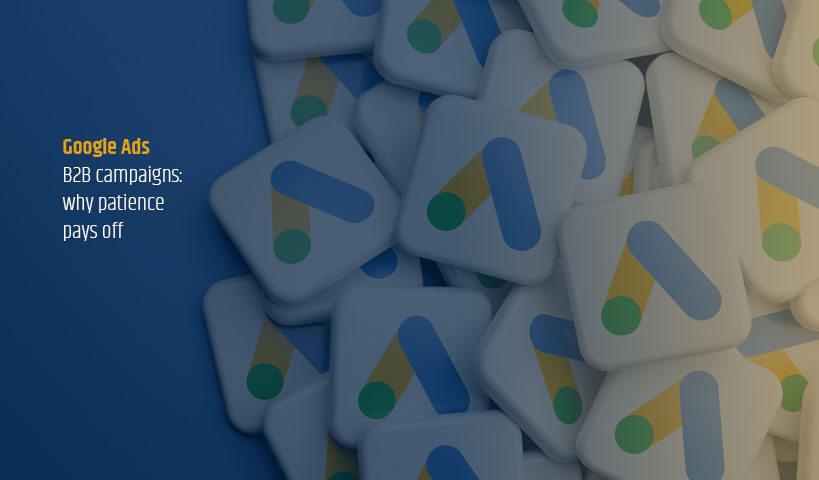
You launched one of those B2B Google Ads campaigns for your company, and after three months, still no satisfying results? You’re thinking of shutting it down? Hold on a second. This blog post is here to remind you of a truth too often overlooked: in B2B digital advertising, patience is a strategy.
How long does it take for a B2B campaign with Google Ads to start performing?
A B2B campaign can take three months to deliver tangible results in terms of return on investment (ROI). (Source: Staenk). A minimum of three months in B2B — that’s great if you’re lucky. If you’re in a simpler sector or one with very low purchase risk, you might get conversions, and therefore purchases, within those first three months.
But we’re talking about the average across all industries. In B2B, while some markets may generate value within three months, others will start generating value only after six months.
Several other criteria influence these time frames, such as product or service awareness, the company’s visibility and credibility. Are we in a saturated market or not? And where are we in our product cycle — just launching, or mature? Purchase risk is also a factor to consider.
In some cases, 12 months are needed to reach real maturity. That’s normal. The more niche your market, the more patience pays off.
Other time-related factors for optimization
Some interrupt their campaigns after only three months, believing the ROI isn’t up to par. However, five other factors explain why it’s crucial to allow time for campaign optimization:
1. Data collection and analysis: At the start of a campaign, the available data is often limited. Drawing conclusions based on thirty clicks is premature.
2. Continuous optimization: B2B campaigns with Google Ads require regular adjustments — adding and excluding search terms (what a user actually typed that led to your ad being shown), analyzing keyword groups, landing pages, calls to action, keyword performance, etc. Simply put, a brand-new campaign is the worst it will ever be.
3. Platform complexity: With frequent algorithm updates and the rise of conversational search, campaign management is becoming more complex. Adapting continuously to new features and best practices is essential.
4. Global strategic approach: We’ve also noticed that the most profitable campaigns are those integrated with other strategies: SEO efforts, social media efforts (and even paid campaigns on social), content strategy…
5. Alignment between marketing and sales: Close collaboration between marketing and sales teams is vital.
And what does sales think of B2B campaigns?
Often, B2B Google Ads campaigns generate leads. Lots of them. But are they qualified?
“Great! This keyword gave me 100 low-cost leads!”
Sales team: “They’re not qualified.”
That’s why collaboration between marketing and sales teams is essential. Regular meetings help ensure the leads generated meet the desired quality criteria. Constant feedback from the sales team helps fine-tune marketing strategies for greater efficiency.
According to a Magileads study, 85% of B2B marketing professionals consider lead generation their main challenge.

Why do some B2B campaigns seem less effective than others?
Because they’re often run in isolation. We want Google Ads to deliver results like ordering takeout coffee: fast, hot, instant. But in B2B marketing, it doesn’t work that way.
Should Google Ads be part of a larger strategy?
The answer is yes — no hesitation. The most effective campaigns are rooted in a content strategy, solid SEO, efforts on social media, and a consistent digital presence. Combining Ads + SEO + content + social media = more touchpoints, more consistency, greater conversion potential.
How do you know if your campaign is off to a bad start?
“Garbage in, garbage out,” as they say.
If your keywords are poorly defined, your landing page unclear, your message vague or too generic… no algorithm can compensate.
Tip: Analyze your search terms — what people REALLY typed before clicking. That’s where the truth hides.
How to optimize a B2B campaigns with Google Ads?
Optimizing B2B campaigns with Google Ads starts with setting clear objectives: Do you want to drive traffic, get conversions, or simply generate contact inquiries? Each goal involves different strategies. Then, it’s essential to structure your ad groups consistently, grouping similar keywords that align with a specific intent.
Landing pages must match the ad message. A promise made in the ad must be fulfilled on the landing page — or your bounce rate will soar. Also, monitor and exclude irrelevant search terms that unnecessarily drain your budget.
Using ad extensions — like sitelinks, call buttons, or location info — enhances your messages and increases your chances of grabbing attention. Finally, no optimization is complete without regular monitoring. Weekly performance analysis helps you identify what’s working… and what needs to change.
In summary: Why your B2B campaigns with Google Ads deserve your patience
Launching a B2B Google Ads campaign isn’t about pressing “Start” and waiting for magic. It’s a rigorous pLaunching a Google Ads B2B campaign isn’t like pressing ‘Start’ and expecting magical results. It’s a rigorous process that requires attention, adjustment and, above all, time.
The most profitable campaigns are built over time. A better understanding of audiences. A more fluid relationship between marketing and sales. Ongoing adjustments that lead to higher conversion rates and a better return on investment.
Take the time to observe. Give your campaigns time to learn and adapt. Integrate them into a coherent overall strategy. Involve your teams. Measure what works. Change what needs to be changed.
And if you’re tempted to call it a day after three months, remember: you could be on the brink of a real turning point.
Thank you for your trust — and your patience.
Having doubts about your current performance? Need a fresh perspective on your B2B Google Ads strategy? Let’s talk. Our team is here to help you build what’s worth building — and optimize what can be improved.




